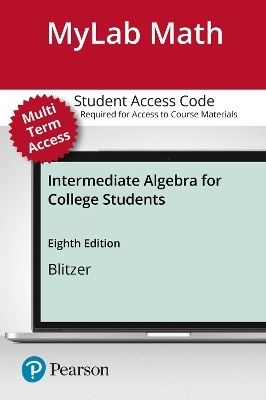
MyLab Math with Pearson eText (up to 24 months) Access Code for Intermediate Algebra for College Students
Pearson (Hersteller)
9780136679196 (ISBN)
- Titel z.Zt. nicht lieferbar
- Versandkostenfrei
- Auch auf Rechnung
- Artikel merken
Used books, rentals, and purchases made outside of Pearson
If purchasing or renting from companies other than Pearson, the access codes for the MyLab platform may not be included, may be incorrect, or may be previously redeemed. Check with the seller before completing your purchase.
For courses in Intermediate Algebra.
This is the standalone 24-month access card for MyLab Math.
Gets them engaged. Keeps them engaged.
Bob Blitzer’s Developmental Algebra Series shows developmental students at all levels how math applies to their daily lives and culture. Blitzer’s use of realistic, interesting applications instantly piques students’ curiosity about mathematical concepts in the world around them. These applications are apparent throughout the entire program — from his student-friendly examples, unique writing style, and thought-provoking features to the digital resources in the MyLab Math course.
In this revision Blitzer updates his hallmark applications, pulling from topics that are relevant to college students — often from pop culture, the news, and everyday life — to ensure that they will actually use their learning resources to achieve success.
Personalize learning with MyLab Math
By combining trusted author content with digital tools and a flexible platform, MyLab Math personalizes the learning experience and improves results for each student.
0136679196 / 9780136679196 MYLAB MATH WITH PEARSON ETEXT -- STANDALONE ACCESS CARD -- FOR INTERMEDIATE ALGEBRA FOR COLLEGE STUDENTS -- 24 MONTHS, 8/e
About our author Bob Blitzer is a native of Manhattan and received a Bachelor of Arts degree with dual majors in mathematics and psychology (minor: English literature) from the City College of New York. His unusual combination of academic interests led him toward a Master of Arts in mathematics from the University of Miami and a doctorate in behavioral sciences from Nova University. Bob’s love for teaching mathematics was nourished for nearly 30 years at Miami Dade College, where he received numerous teaching awards, including Innovator of the Year from the League for Innovations in the Community College and an endowed chair based on excellence in the classroom. Bob has written textbooks covering developmental mathematics, introductory algebra, intermediate algebra, algebra & trigonometry, trigonometry, college algebra, precalculus, and liberal arts mathematics, all published by Pearson. When not secluded in his Northern California writer’s cabin, Bob can be found hiking the beaches and trails of Point Reyes National Seashore and tending to the chores required by his beloved entourage of horses, chickens, and irritable roosters.
Algebra, Mathematical Models, and Problem Solving
1.1 Algebraic Expressions, Real Numbers, and Interval Notation
1.2 Operations with Real Numbers and Simplifying Algebraic Expressions
1.3 Graphing Equations
1.4 Solving Linear Equations
Mid-Chapter Check Point
1.5 Problem Solving and Using Formulas
1.6 Properties of Integral Exponents
1.7 Scientific Notation
Functions and Linear Functions
2.1 Introduction to Functions
2.2 Graphs of Functions
2.3 The Algebra of Functions
Mid-Chapter Check Point
2.4 Linear Functions and Slope
2.5 The Point-Slope Form of the Equation of a Line
Systems of Linear Equations
3.1 Systems of Linear Equations in Two Variables
3.2 Problem Solving and Business Applications Using Systems of Equations
3.3 Systems of Linear Equations in Three Variables
Mid-Chapter Check Point
3.4 Matrix Solutions to Linear Systems
3.5 Determinants and Cramer’s Rule
Inequalities and Problem Solving
4.1 Solving Linear Inequalities
4.2 Compound Inequalities
4.3 Equations and Inequalities Involving Absolute Value
Mid-Chapter Check Point
4.4 Linear Inequalities in Two Variables
4.5 Linear Programming
Polynomials, Polynomial Functions, and Factoring
5.1 Introduction to Polynomials and Polynomial Functions
5.2 Multiplication of Polynomials
5.3 Greatest Common Factors and Factoring by Grouping
5.4 Factoring Trinomials
Mid-Chapter Check Point
5.5 Factoring Special Forms
5.6 A General Factoring Strategy
5.7 Polynomial Equations and Their Applications
Rational Expressions, Functions, and Equations
6.1 Rational Expressions and Functions; Multiplying and Dividing
6.2 Adding and Subtracting Rational Expressions
6.3 Complex Rational Expressions
6.4 Division of Polynomials
Mid-Chapter Check Point
6.5 Synthetic Division and the Remainder Theorem
6.6 Rational Equations
6.7 Formulas and Applications of Rational Equations
6.8 Modeling Using Variation
Radicals, Radical Functions, and Rational Exponents
7.1 Radical Expressions and Functions
7.2 Rational Exponents
7.3 Multiplying and Simplifying Radical Expressions
7.4 Adding, Subtracting, and Dividing Radical Expressions
Mid-Chapter Check Point
7.5 Multiplying with More Than One Term and Rationalizing Denominators
7.6 Radical Equations
7.7 Complex Numbers
Quadratic Equations and Functions
8.1 The Square Root Property and Completing the Square
8.2 The Quadratic Formula
8.3 Quadratic Functions and Their Graphs
Mid-Chapter Check Point
8.4 Equations Quadratic in Form
8.5 Polynomial and Rational Inequalities
Exponents and Logarithmic Functions
9.1 Exponential Functions
9.2 Composite and Inverse Functions
9.3 Logarithmic Functions
9.4 Properties of Logarithms
Mid-Chapter Check Point
9.5 Exponential and Logarithmic Equations
9.6 Exponential Growth and Decay; Modeling Data
Conic Sections and Systems of Nonlinear Equations
10.1 Distance and Midpoint Formulas; Circles
10.2 The Ellipse
10.3 The Hyperbola
Mid-Chapter Check Point
10.4 The Parabola; Identifying Conic Sections
10.5 Systems of Nonlinear Equations in Two Variables
Sequences, Series, and the Binomial Theorem
11.1 Sequences and Summation Notation
11.2 Arithmetic Sequences
11.3 Geometric Sequences and Series
Mid-Chapter Check Point
11.4 The Binomial Theorem
| Erscheint lt. Verlag | 28.4.2021 |
|---|---|
| Sprache | englisch |
| Themenwelt | Mathematik / Informatik ► Mathematik ► Algebra |
| ISBN-13 | 9780136679196 / 9780136679196 |
| Zustand | Neuware |
| Informationen gemäß Produktsicherheitsverordnung (GPSR) | |
| Haben Sie eine Frage zum Produkt? |
aus dem Bereich
